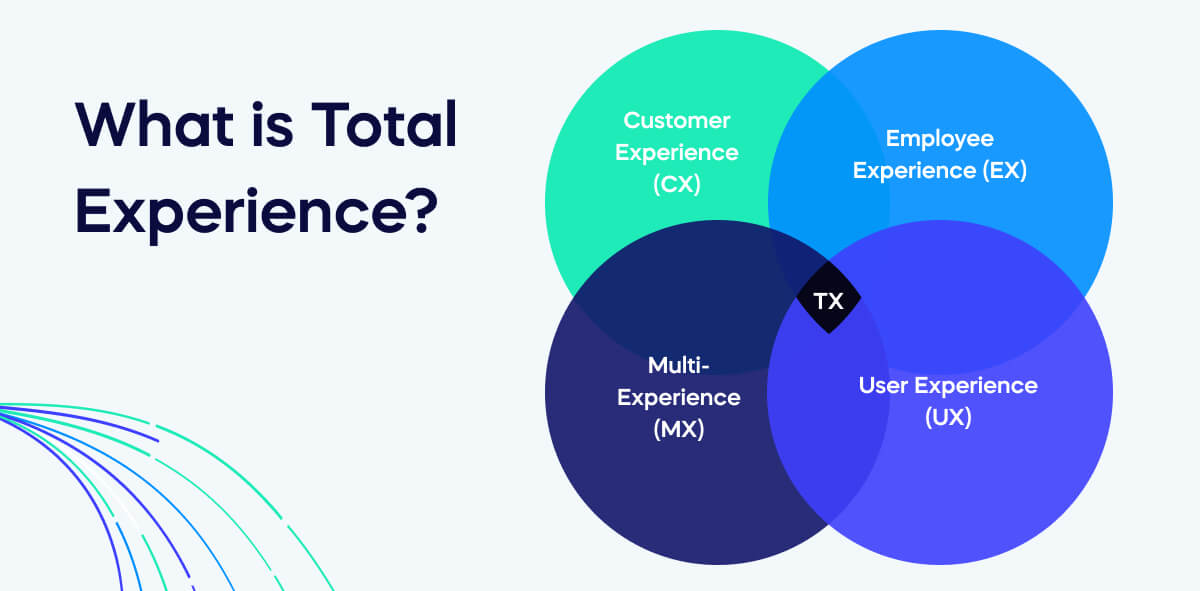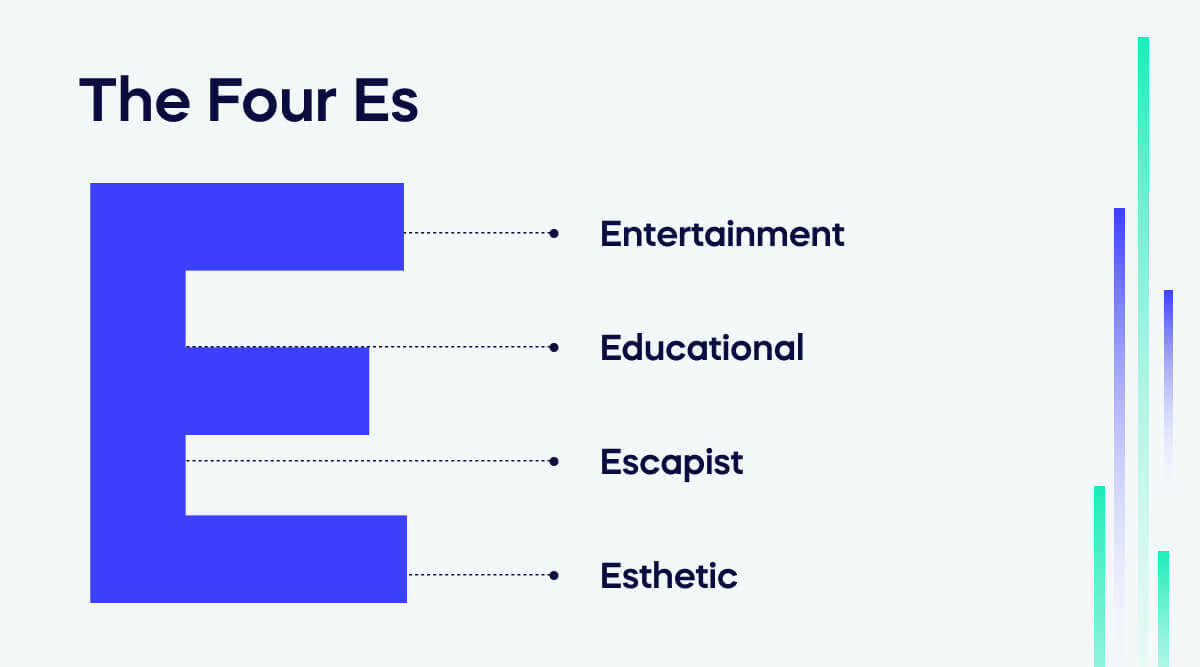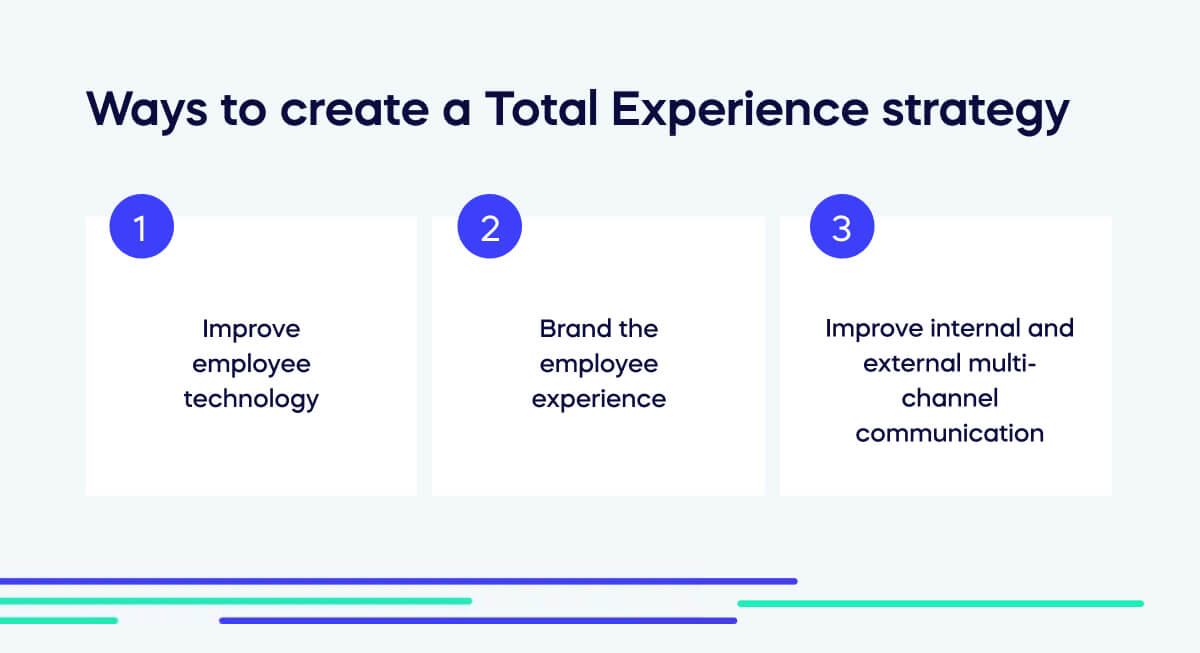Total experience definition
Total Experience (TX) focuses on designing and delivering exceptional experiences in a holistic and integrated way for the employee, the customer, and the user.
The result is an environment that is not only excellent for the customer at all touchpoints but also a positive experience for those involved with the company on other levels.

Multiple disciplines are combined across a range of touchpoints for TX:
Customer experience (CX)
The journey a customer goes on with a brand, from the moment they first become aware of the company to the point of purchase and beyond.
Positive customer experience generates loyalty, improves customer satisfaction, and encourages repeat business.
Factors contributing to good customer experience include user-friendly interfaces, responsive customer support, personalized marketing, and seamless interactions that promote favorable impressions of the brand.
Employee experience (EX)
Employee experience describes the end-to-end creation of a positive work environment for employees. A company will ensure workers have the tools, resources, support, and opportunities to perform their best, grow professionally, and feel satisfied.
A good employee experience leads to higher job satisfaction, improved productivity, reduced turnover, and a stronger sense of loyalty to the organization.
Factors contributing to EX include effective communication, career development programs, work-life balance, recognition, and a healthy organizational culture.
User experience (UX)
The experience users have when they interact with a product, service, website, or app. The aim is to make the experience intuitive, efficient, and enjoyable.
UX design focuses on understanding user needs, preferences, and behaviors so that easily navigable, visually appealing, and functional interfaces can be designed.
The benefits of a positive user experience include increased user satisfaction, better engagement, and higher conversion rates.
Features like clear navigation, responsive design, and thoughtful content presentation combine to create a strong overall UX.
Multi-experience (MX)
MX is a strategy for providing users with seamless and consistent experiences across multiple channels, devices, and touchpoints.
At the core of multi-experience is the understanding that users interact with brands in various ways, such as via websites, mobile apps, chatbots, AR, VR, and more.
MX aims to create a unified and integrated experience, allowing users to move between these mediums without disruption or loss of context.
Creating total experience
The goal of Total Experience is to combine these four disciplines, enhancing the customer experience while also improving the business as a whole.
Here are some of the ways in which the disciplines interact to form TX:
Customer experience and employee experience
Good workplace conditions – When employees feel positive about their experience in the workplace, they are more likely to be committed to delivering excellent customer service.
Training and development – When staff are given opportunities to grow in the workplace with employee training, they will be empowered to provide better customer support. Customer satisfaction will improve as a result.
Customer experience and user experience
Good impressions – When users interact with products and services that are easy to use and navigate, their image of the brand overall will improve.
Consistent branding – Customers who encounter consistent messaging across multiple touch points thanks to well-designed UX will have a unified and positive experience with the brand.
Employee experience user Experience and customer experience
Cross-functional understanding – Employee initiatives that promote cross-functional knowledge of user experience can help employees responsible for delivering customer support to understand the perspective of UX designers, subsequently helping to provide higher-quality customer support and improving customer satisfaction.
What is the Experience Economy?
Experience economy is the concept of selling an unforgettable experience to customers. The term was popularized by B Joseph Pine II and James H Gilmore, who said that by creating memorable events for customers, the memory of the experience becomes the ‘product’ that is sold.
In other words, by selling a fantastic experience, the customer will remember it, associate positively with the brand, and engage with it more.
The four Es
Pine and Gilmore discuss the four realms of customer experience, the Four Es. They are as follows:
Entertainment
- Customers are passive observers or audiences.
- The experience is designed for enjoyment and entertainment
- They may attend a concert, watch a movie, or go to the theater
- The customer is immersed in a scripted experience
- They have limited interaction or influence on the course of events
Educational
- Customers are part of a learning experience
- They take part in activities where they gain knowledge and develop skills
- They may attend workshops, seminars, or training sessions
- They are engaged in the experience as they acquire new information
Escapist
- Customers immerse themselves in an experience where they escape from reality.
- Role-playing or simulation are the main elements
- They may go to theme parks, video games, or immersive theater
- They are engaged in the experience, adopting new personas or realities
Esthetic
- Customers appreciate the beauty and sensory appeal of an experience
- The main features are emotional connection and immersion
- They may visit art galleries, enjoy fine dining, or have a spa treatment
- The experience engages their senses and evokes their emotions

How are experience economy and total experience connected?
Experience Economy and Total Experience emphasize creating immersive experiences that add value for customers, employees, and users.
Both necessitate a transition towards offering constructive engagements beyond mere product or service purchases, transforming an organizational proposal into a valuable takeaway.
Let’s look at the connection between these two concepts in practice with an example: Walt Disney.
How Walt Disney provides total experience and the four Es
Customer experience, escapism & esthetic
Disney theme parks – These attractions are designed with meticulous attention to detail, aiming to provide visitors with a magical and unforgettable experience. Customers can temporarily escape from everyday life by immersing themselves in the world of Disney. The experience will be emotional and sensory-oriented, with bright colors and immersive sound.
Employee experience & education
Workplace training programs – As an employer, Disney greatly emphasizes employee training, ensuring that everyone from theme park cast members to software engineers are well-equipped to perform their roles. Disney offers an education investment program called Disney Aspire, allowing employees to pay tuition at several colleges and universities. Overall, the employee experience is highly valuable and beneficial for the workforce.
User experience & entertainment
Disney Plus – The streaming platform delivers a user-centric experience, allowing subscribers to access a wide range of content tailored to their preferences. They can immerse themselves in scripted experiences, entertained by the platform’s movies and TV shows.
Benefits of total experience
Gartner has predicted that by 2024, organizations that have deployed a comprehensive TX strategy will be doing 25% better than their competitors regarding satisfaction metrics.
To find out why this prediction has been made, let’s dig into the benefits of rolling out a Total experience strategy:
Improved brand loyalty
By working holistically to action customer feedback, develop improved products and services, and build brand consistency, customers will have a better impression of the brand. This will lead to higher customer retention and improved brand loyalty.
Improved brand awareness
Brands that implement consistent messaging across multiple touchpoints (MX) along with good UX and positive experiences with employees are much more memorable, leading to a cohesive awareness that will spread more easily.
Fewer business silos
Without TX implementation, UX, CX, MX, and EX will rarely unite for a project and instead move in silos from stage to stage, with each discipline having little or no understanding of the others. With TX, disciplines work holistically with full transparency so that all involved will understand others’ needs and the end goal being worked towards. Multi-cloud architecture and cloud transformation can help with this process.
Fostering innovation
By breaking down business silos, employees, customers, and users can all contribute feedback and insights in a centralized hub which can, in turn, spark creative ideas. As a result, TX’s strategy can naturally result in a workplace culture that fosters innovation and cross-departmental collaboration.
Higher productivity
Employees will feel valued and supported when they are given a more positive experience with changes such as improved UX for their own systems and enhanced understanding of how other business operations work. As a result, they will be more likely to perform at their best.
Ways to create a Total experience strategy
Here are a few ways companies can begin working on their TX strategy, enhancing the customer experience and improving the business.

Improve employee technology
Invest in improved user interfaces for your employees as well as your customers. By enabling employees to work more easily, they will be motivated to increase their productivity and feel valued. Motivated employees lead to more positive customer interactions, which helps drive business.
Brand the employee experience.
Consumers are looking beyond the experience provided by brands and analyzing the treatment employees receive. Branding the employee experience helps to foster positive internal and external communications, as employees will feel positive and consumers will look favorably on brands. Branding the employee experience includes developing a strong corporate culture and an employee-first attitude.
Improve internal and external multi-channel communication.
Seamless multi-channel communication is valued highly by customers, and it will improve both satisfaction and loyalty. However, ensuring that such communications are also seamless internally will result in an optimal experience across the board. Employers should work on delivering solutions that connect workers in various locations and foster seamless digital and in-person communications.

